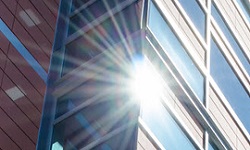Smart windows: A no-brainer for future buildings
Windows are one of the most determining aspects in the conception and design of energy-efficient buildings. In Europe only, excessive heat loss and gain through windows are deemed to account for about 4 % of Europe's total energy consumption. Reducing this energy bill is one of the main challenges facing industry, and the market is already getting to grips with it. The first stage of technological evolution mostly saw glazing technology move away from single- to double- and now tripled-glazed windows. But whilst this already represents a dramatic change, the true revolution is only about to hit the market: ‘Smart windows’ – a concept encompassing novel technologies that help control or store the light and heat transferred from outdoor in – will soon be a must have on the product lists of all market players. According to a recent report by Research and Markets, the global revenues from electrochromic (EC) glass and films – special glass coating controlled with a manual switch which can block up to 98% of solar radiation – will reach EUR 580 million by 2024. Other smart window solutions like photochromic, thermochromic, SPD, PDLC, hydrogel, pixel-based and microblind technologies would bring up this value to over EUR 650 million. These facts raise a fundamental question: is the EU industry technologically ready to claim a substantial share of this emerging market? Over the past few years the EU has been lending market players a hand to ensure that they will be ready when the time comes. This CORDIS Results Pack covers some of the most exciting technologies being developed within this framework, ranging from advanced EC film technologies to lightweight materials, quadruple glazing, energy-harvesting solutions and other innovative approaches to insulation and energy efficiency.



